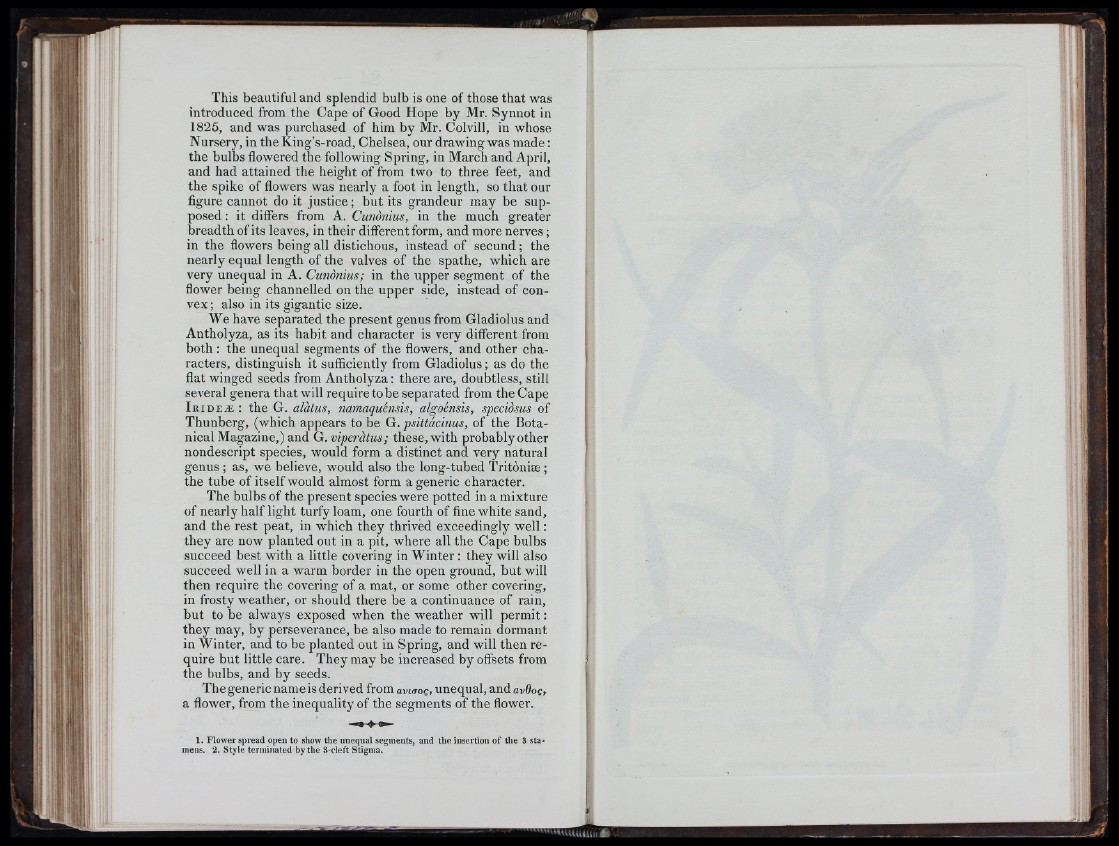
U!
JS
This beautiful and splendid bulb is one of those that was
introduced from the Cape of Good Hope by Mr. Synnot in
1825, and was purchased of him by Mr. Colvill, in whose
Nursery, in the King’s-road, Chelsea, our drawing was made:
the bulbs flowered the following Spring, in March and April,
and had attained the height of from two to three feet, and
the spike of flowers was nearly a foot in length, so that our
figure cannot do it justic e; but its grandeur may be supposed
: it differs from A. Cundnius, in the much greater
breadth of its leaves, in their different form, and more nerves;
in the flowers being all distichous, instead of secund; the
nearly equal length of the valves of the spathe, which are
very unequal in A. Cundnius; in the upper segment of the
flower being channelled on the upper side, instead of convex;
also in its gigantic size.
We have separated the present genus from Gladiolus and
Antholyza, as its habit and character is very different from
both : the unequal segments of the flowers, and other characters,
distinguish it sufficiently from Gladiolus; as do the
flat winged seeds from Antholyza: there are, doubtless, still
several genera that will require to be separated from the Cape
I r id e a ; : the G. alatus, namaquensis, algotnsis, specidsus of
Thunberg, (which appears to be G. psittacinus, of the Botanical
Magazine,) and G. viperdtus; these, with probably other
nondescript species, would form a distinct and very natural
genus; as, we believe, would also the long-tubed Tritdniae;
the tube of itself would almost form a generic character.
The bulbs of the present species were potted in a mixture
of nearly half light turfy loam, one fourth of fine white sand,
and the rest peat, in which they thrived exceedingly w e ll:
they are now planted out in a pit, where all the Cape bulbs
succeed best with a little covering in Winter: they will also
succeed well in a warm border in the open ground, but will
then require the covering of a mat, or some other covering,
in frosty weather, or should there be a continuance of rain,
but to be always exposed when the weather will permit:
they may, by perseverance, be also made to remain dormant
in Winter, and to be planted out in Spring, and will then require
but little care. They may be increased by offsets from
the bulbs, and by seeds.
The generic name is derived from avitroe, unequal, and avOog,
a flower, from the inequality of the segments of the flower.
1. Flower spread open to show the unequal segments, and the insertion of the 3 stamens.
2. Style terminated by the 3-cleft Stigma.
■'UUUUlUliA'